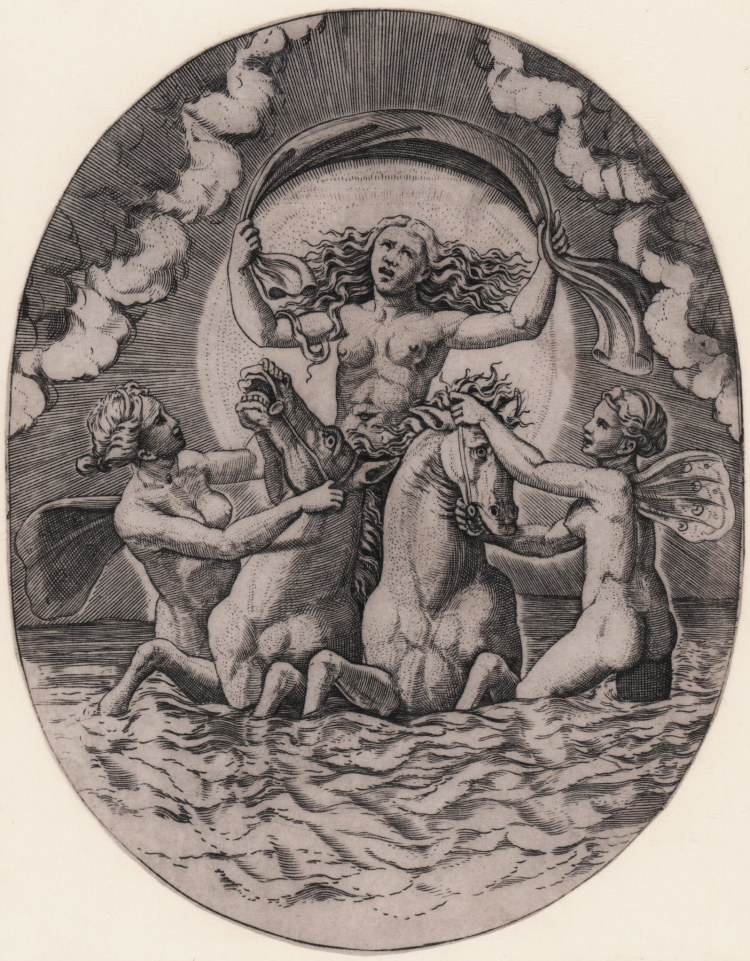




| Reference: | S5229 |
| Author | Agostino de Musi detto VENEZIANO |
| Year: | 1520 ca. |
| Measures: | 134 x 173 mm |



| Reference: | S5229 |
| Author | Agostino de Musi detto VENEZIANO |
| Year: | 1520 ca. |
| Measures: | 134 x 173 mm |
Engraving, 1510-1530 circa. After Raphael.
Mind example, printed on contemporary laid paper, trimmed close to platemark, in excellent condition.
Formerly attributed to Marcantonio Raimondi, the plate shows a nude Aurora behind two horses rising from the sea, which each horses attended by a butterfly-winged figure.
Bartsch probably mistakenly described the work as after 'Luna' of the series of four planetary divinities on the ceiling of the Sala Borgia in the Vatican, painted by Giovanni da Udine and Perino del Vaga. The print is attributed to Agostino Musi on the British Museum database, inv. no. H,2.52.
According to Ruland (1876) this print is related to the commission by Count Baldassarre Castiglione to Raphael (1514) of a medal to be used as his 'impresa' (motto). This medal has been identified with one in the British Museum (inv. no. G3,IP.309) and one in the National Gallery of Art, Washington (inv. no. 1957.14.899.b).
Albury (Castiglione’s Allegory…) uses this print to confirm that the central figure represented in these medals is actually Aurora. The medals feature a portrait of Castiglione on the observe and the figure of Aurora on the reverse (the inscription reads 'Of darkness and light'). The medal in the British Museum is catalogued as by an anonymous Roman medallist, possibly after a design by Raphael.
Raphael and Baldassare Castiglione, a scholar-diplomat and author of the famous book of etiquette, 'The Courtier', both moved in the same artistic and intellectual circles within the papal court.
|
Bartsch XIV.222.293; Delaborde 1887, no.125; Oberhuber 1, 281; Ruland p. 308 A.IV.2.
|
Agostino de Musi detto VENEZIANO (Venezia 1490 ca. - Roma 1536/38)
|
Heir of the great tradition of the Raimondi’s, Agostino Musi, from the family de Masyus or dè Musis, also known as the Veneziano, derives his nick name from the city where he studied the “giorgionesco” style of Giulio Campagnola, di Jacopo dè Barbari and Dürer.
For a while, Agostino lived in Florence translating works from Andrea del Sarto. After that, he moved to Rome where he started working in the workshop of Bavero di Carrocci (aka Baviera) from 1516 till the Sack (Sacco) of the City.
After the Sack, he very likely went back to Florence and maybe Mantua, where he worked on Giulio Romano’s production. Between 1530 and 1531 Agostino went back to Rome and engraved the marvellous Vasi antichi e moderni, with the coats of arms of Clemente VII de Medici; in this work it can be seen his own, peculiar, ornamental style, which he used to realize splendid works for the first, great Roman publisher, Antonio Salamanca.
Bartsch ascribes to him 181 prints, dated between 1509 and 1536; Passavant then added other seven subjects (VI, pp. 49-68).
|
|
Bartsch XIV.222.293; Delaborde 1887, no.125; Oberhuber 1, 281; Ruland p. 308 A.IV.2.
|
Agostino de Musi detto VENEZIANO (Venezia 1490 ca. - Roma 1536/38)
|
Heir of the great tradition of the Raimondi’s, Agostino Musi, from the family de Masyus or dè Musis, also known as the Veneziano, derives his nick name from the city where he studied the “giorgionesco” style of Giulio Campagnola, di Jacopo dè Barbari and Dürer.
For a while, Agostino lived in Florence translating works from Andrea del Sarto. After that, he moved to Rome where he started working in the workshop of Bavero di Carrocci (aka Baviera) from 1516 till the Sack (Sacco) of the City.
After the Sack, he very likely went back to Florence and maybe Mantua, where he worked on Giulio Romano’s production. Between 1530 and 1531 Agostino went back to Rome and engraved the marvellous Vasi antichi e moderni, with the coats of arms of Clemente VII de Medici; in this work it can be seen his own, peculiar, ornamental style, which he used to realize splendid works for the first, great Roman publisher, Antonio Salamanca.
Bartsch ascribes to him 181 prints, dated between 1509 and 1536; Passavant then added other seven subjects (VI, pp. 49-68).
|